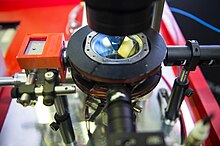Atom interferometer
An atom interferometer is an
Overview
Interferometer types

While the use of atoms offers easy access to higher frequencies (and thus accuracies) than
The early atom interferometers deployed slits or wires for the beam splitters and mirrors. Later systems, especially the guided ones, used light forces for splitting and reflecting of the matter wave.[7]
Examples
| Group | Year | Atomic species | Method | Measured effect(s) |
|---|---|---|---|---|
| Pritchard | 1991 | Na, Na2 | Nano-fabricated gratings | Polarizability, index of refraction |
| Clauser | 1994 | K | Talbot-Lau interferometer | |
| Zeilinger | 1995 | Ar | Standing light wave diffraction gratings | |
| Helmke Bordé |
1991 | Ramsey–Bordé | Polarizability, Aharonov–Bohm effect: exp/theo , Sagnac effect 0.3 rad/s/Hz | |
| Chu | 1991 1998 |
Na
Cs |
Kasevich - Chu interferometer Light pulses Raman diffraction |
Gravimeter : Fine-structure constant: |
| Kasevich | 1997 1998 |
Cs | Light pulses Raman diffraction | Gyroscope: rad/s/Hz, Gradiometer: |
| Berman | Talbot-Lau |
History
Interference of atom matter waves was first observed by Immanuel Estermann and Otto Stern in 1930, when a sodium (Na) beam was diffracted off a surface of sodium chloride (NaCl).[8] The first modern atom interferometer reported was a double-slit experiment with metastable helium atoms and a microfabricated double slit by O. Carnal and Jürgen Mlynek in 1991,[9] and an interferometer using three microfabricated diffraction gratings and Na atoms in the group around David E. Pritchard at the Massachusetts Institute of Technology (MIT).[10] Shortly afterwards, an optical version of a Ramsey spectrometer typically used in atomic clocks was recognized also as an atom interferometer at the Physikalisch-Technische Bundesanstalt (PTB) in Braunschweig, Germany.[11] The largest physical separation between the partial wave packets of atoms was achieved using laser cooling techniques and stimulated Raman transitions by Steven Chu and his coworkers in Stanford University.[12]
In 1999, the diffraction of C60
In 2003, the Vienna group also demonstrated the wave nature of
The 2008 comprehensive review by Alexander D. Cronin, Jörg Schmiedmayer, and David E. Pritchard documents many new experimental approaches to atom interferometry.[22] More recently atom interferometers have begun moving out of laboratory conditions and have begun to address a variety of applications in real world environments.[23][24]
Applications
Gravitational physics
A precise measurement of gravitational redshift was made in 2009 by Holger Muller, Achim Peters, and Steven Chu. No violations of general relativity were found to 7 × 10-9.[25]
In 2020, Peter Asenbaum, Chris Overstreet, Minjeong Kim, Joseph Curti, and Mark A. Kasevich used atom interferometry to test the principle of equivalence in general relativity. They found no violations to about 10-12.[26][27]
The first team to make a working model, Pritchard's, was propelled by
See also
References
- ISBN 978-0-133-97722-6.
- S2CID 118837118.
- PMID 35197616.
- S2CID 28009912.
- .
- S2CID 55687641.
- PMID 10059366.
- S2CID 121757478.
- PMID 10043591.
- S2CID 6559338.
- PMID 10044514.
- S2CID 30845889.
- S2CID 4424892.)
{{cite journal}}: CS1 maint: multiple names: authors list (link - S2CID 5918772.
- ^ S2CID 13533517.
- PMID 9910609.
- S2CID 19793304.
- S2CID 31057272.
- S2CID 3482856.
- PMID 21468015.
- S2CID 3944699.
- S2CID 28009912.
- S2CID 209940190.
- PMID 37688106.
- S2CID 4317164.
- S2CID 218869931.
- ^ Conover, Emily (October 28, 2020). "Galileo's famous gravity experiment holds up, even with individual atoms". Science News. Retrieved August 6, 2023.
- ^ Rotman, David (February 8, 2013). "A Cheap and Easy Plan to Stop Global Warming". MIT Technology Review. Retrieved 1 July 2021.
- PMID 22778644.
- ^ Advances in Atomic Gyroscopes: A View from Inertial Navigation Applications. Full PDF
- ^ Cold Atom Gyros – IEEE Sensors 2013
External links
- P. R. Berman [Editor], Atom Interferometry. Academic Press (1997). Detailed overview of atom interferometers at that time (good introductions and theory).
- Stedman Review of the Sagnac Effect





